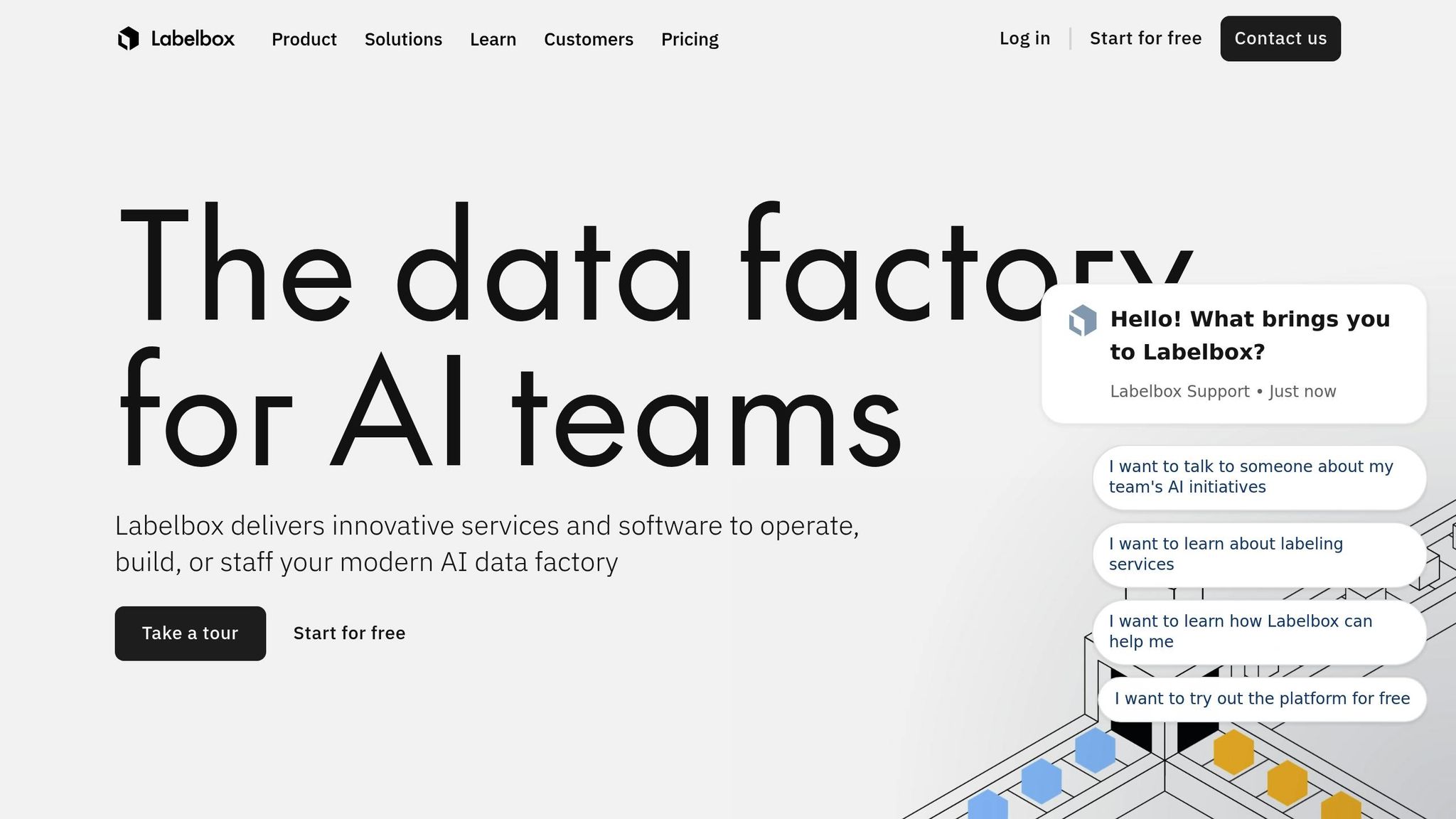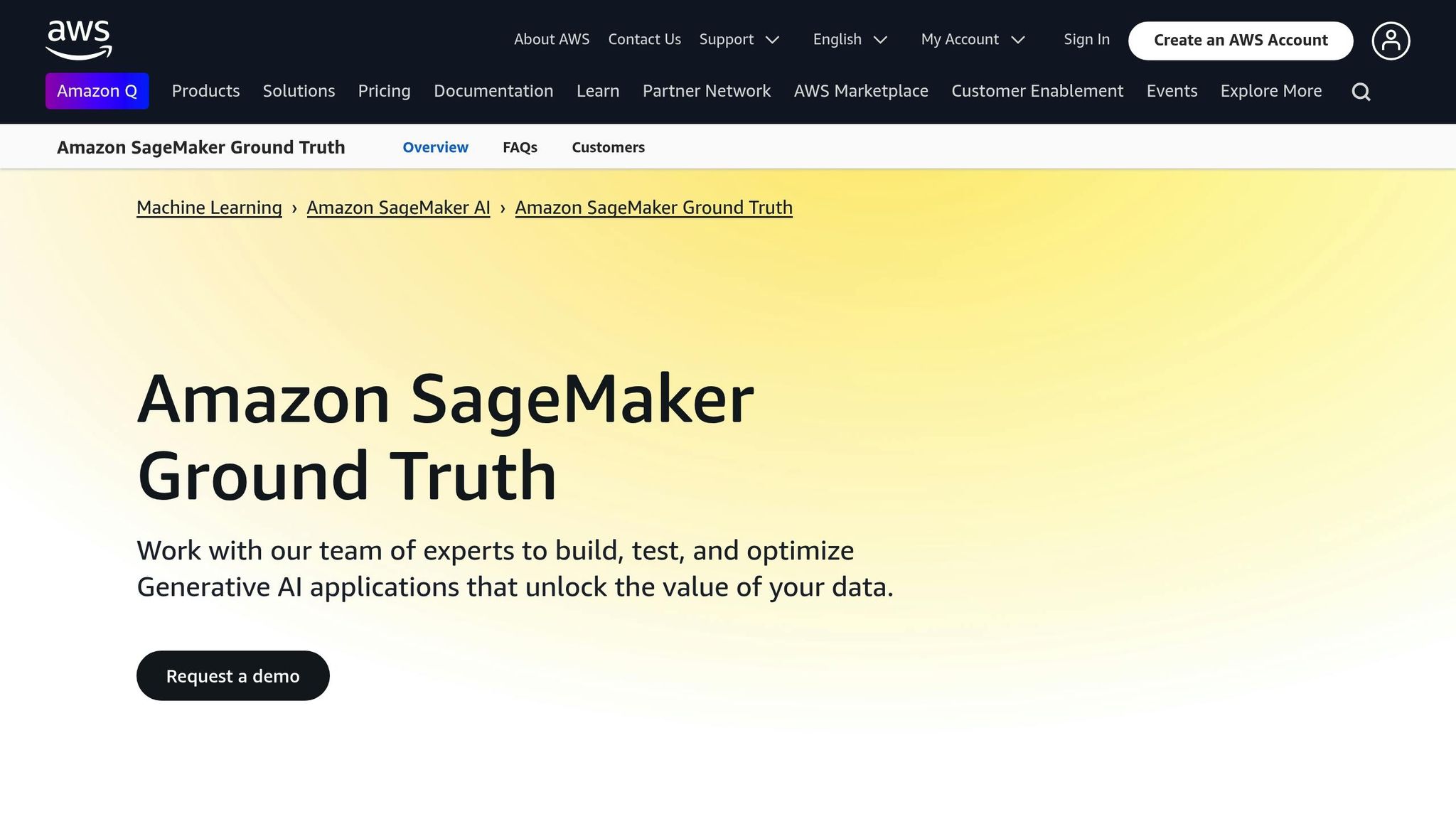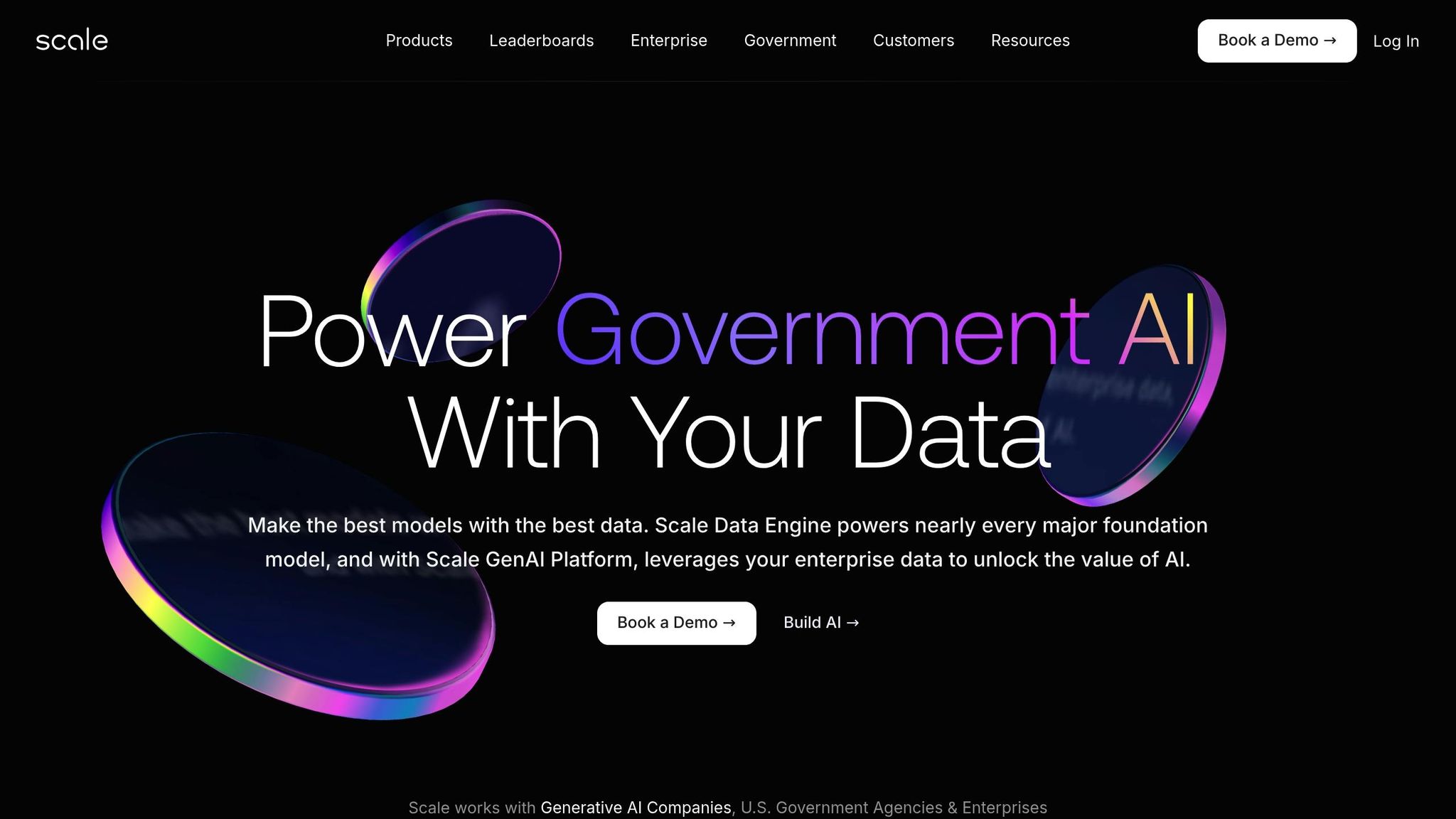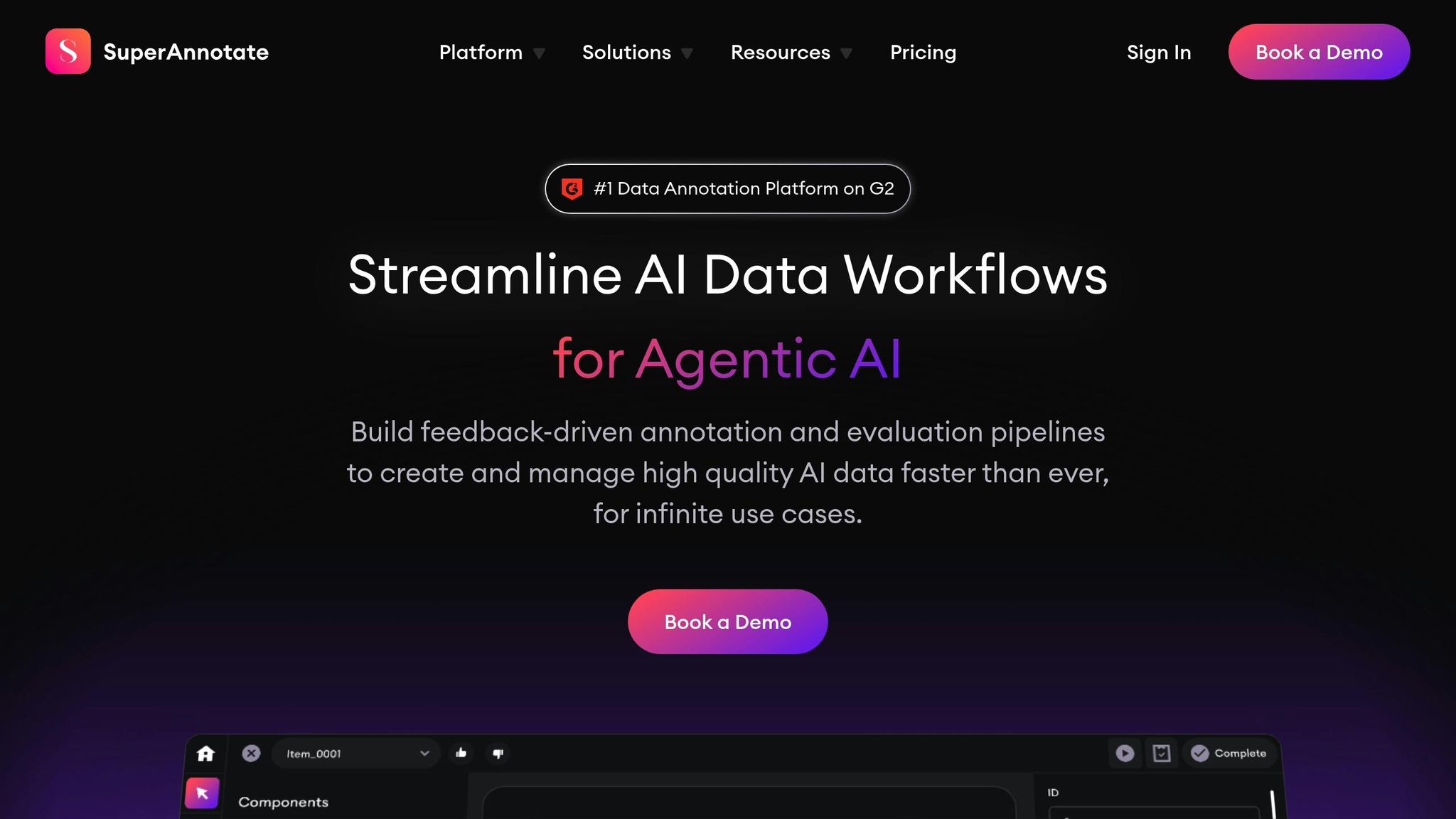85% of AI projects fail due to poor data quality, costing the U.S. economy $3.1 trillion annually. Fixing this issue starts with high-quality data annotation, which can improve AI model accuracy by up to 35%. Here’s a quick overview of five solutions that can help:
- Data Annotation Companies: Offer tailored solutions with skilled annotators for accuracy and scalability.
- Labelbox: Combines automation and human expertise for large-scale, high-quality annotations.
- Amazon SageMaker Ground Truth: Uses active learning to cut costs and improve accuracy, ideal for AWS users.
- Scale AI: Provides enterprise-level solutions with a 98–99% accuracy rate and strong scalability.
- SuperAnnotate: All-in-one platform with advanced tools for fast scaling and quality control.
Quick Comparison
| Solution | Key Benefits | Limitations | Best For |
|---|---|---|---|
| Data Annotation Companies | Skilled annotators, custom workflows | Requires oversight | Projects needing tailored solutions |
| Labelbox | Automation + human expertise | Has a learning curve | Complex, multi-modal projects |
| Amazon SageMaker Ground Truth | Cost-effective with AWS integration | AWS dependency, technical expertise | AI projects on AWS infrastructure |
| Scale AI | High accuracy, scalable | Premium pricing | Large-scale or high-stakes AI applications |
| SuperAnnotate | Fast scaling, centralized tools | Initial complexity for simple tasks | Computer vision or large datasets |
Investing in the right annotation solution can save time, reduce costs, and significantly improve AI performance. Make sure to choose based on your project’s size, data type, and workflow needs.
10 best annotation tools for computer vision applications
1. Data Annotation Companies
Data annotation companies bring together skilled annotators and cutting-edge technology to deliver accurate and consistent labels for AI models. It’s worth noting that as much as 80% of the time spent developing AI is dedicated to data annotation. With McKinsey predicting AI could contribute approximately $13 trillion to the global economy by 2030, the importance of quality annotation in advancing AI cannot be overstated. Let’s dive into how these companies ensure accuracy, scalability, seamless integration, and compliance.
Annotation Accuracy and Consistency
Maintaining accuracy in data annotation is no small feat. Companies tackle this challenge by relying on experienced annotators who undergo rigorous training. They also implement robust quality assurance processes that combine automated tools with manual reviews. To measure annotation quality, metrics like IAA, Cohen’s Kappa, Fleiss’ Kappa, Krippendorf’s Alpha, and F1 Score are commonly used.
To ensure consistency across projects, clear guidelines and structured review cycles are put in place. Many companies also use consensus pipelines, where multiple annotators review and agree on labels, minimizing errors and maintaining uniformity.
Scalability for Large Datasets
Scaling is essential, especially with large language models requiring anywhere from 50,000 to 200,000 examples to perform effectively. Companies like Sigma AI, for instance, have a pool of 25,000 vetted annotators ready to handle massive datasets.
"Quality assurance begins with our staffing selection process. Unlike traditional staffing or Business Process Outsourcing firms, we have developed specialized assessments to identify the exact skills required for each project. Our research has proven that this approach produces a higher level of quality from the start."
- Valentina Vendola, Manager at Sigma
For more complex tasks, annotators may need up to two months of training. To manage large-scale projects, professional annotation providers often roll out work in phases, run pilot programs, establish clear communication lines, and hold regular team meetings.
Integration with AI Workflows
Once scaled, annotation solutions must fit smoothly into existing AI workflows. Leading data annotation companies offer advanced tools, efficient workforce management, and stringent quality control measures to ensure seamless integration. Many providers support diverse data types - like images, videos, text, audio, and 3D point clouds - and deliver outputs that are compatible with standard AI pipelines.
Cloud integration is another key feature. Many annotation platforms provide direct connections to major cloud services such as AWS, Google Cloud Platform, and Microsoft Azure, making it easier to manage and process data.
Support for US-Centric Formats and Standards
For organizations in the U.S., compliance with domestic regulations and standards is critical. Data annotation companies address this by offering features tailored to U.S. requirements, such as HIPAA compliance for healthcare data or FedRAMP certification for government projects.
Interestingly, the data annotation tools market is expected to grow at a compound annual growth rate of 21.8% between 2024 and 2032. When choosing an annotation provider, it’s important to assess your specific needs - whether that’s support for certain data types, processing speed, or security measures - to ensure the provider aligns with your workflows and risk management strategies.
2. Labelbox

Labelbox is a platform designed to help AI teams produce high-quality data at scale. By combining automation with human expertise, it tackles the problem of poor data quality in annotations. With its customers generating over 50 million annotations every month, Labelbox has demonstrated its ability to meet the demands of enterprise-level operations. Let’s take a closer look at how Labelbox ensures accuracy, handles large-scale projects, and integrates smoothly with AI workflows.
Annotation Accuracy and Consistency
Labelbox ensures precise and consistent annotations through Benchmarking and Consensus Scoring. Benchmarking relies on gold-standard labels, while consensus scoring compares multiple annotations to identify the most accurate result. The platform uses established metrics like IRA and Krippendorff's Alpha to maintain consistency and measure quality.
To further support quality assurance, Labelbox offers a Performance Dashboard. This tool gives teams real-time insights into key metrics like throughput, efficiency, and quality. By breaking down these metrics, project managers can quickly spot and address potential issues, ensuring smooth operations throughout the annotation process.
Scalability for Large Datasets
Scaling annotation efforts without compromising quality is a challenge, but Labelbox manages this with an iterative approach. The process begins with a calibration phase to establish consistency, followed by a production phase to handle larger volumes. This phased approach allows teams to gradually expand their workforce while maintaining high standards.
For organizations that lack internal resources, Labelbox also offers fully managed labeling services. These services handle the entire annotation process, making it easier for companies to scale without sacrificing quality.
Integration with AI Workflows
Labelbox’s APIs and SDKs make it easy to integrate with existing AI pipelines. The platform supports customizable workflows that simplify project management and streamline review processes. It also allows teams to import data from more than 25 sources, ensuring compatibility with various storage and management systems.
Customization is another strength. Teams can tailor labeling schemas and data rendering to meet specific project needs. For example, a recent case study highlighted how a company’s document intelligence team doubled its data quality in just two months by leveraging Labelbox’s expert labelers and human evaluation tools. Additionally, the platform supports multi-step review pipelines, hierarchical structures, and nested classifications, enabling teams to create detailed ontologies that align with their unique requirements.
3. Amazon SageMaker Ground Truth

Amazon SageMaker Ground Truth is a managed labeling service designed to improve data quality by combining human expertise with machine learning automation. It creates precise training datasets for various data types - such as images, text, video, and 3D point clouds - and can lower labeling costs by up to 70% using active learning techniques. Let’s take a closer look at how Ground Truth ensures accurate annotations and supports large-scale AI projects.
Annotation Accuracy and Consistency
Ground Truth tackles annotation inconsistencies with its label consolidation algorithm. This algorithm assigns each data object to multiple workers and merges their responses into a single, refined label, effectively reducing errors and bias.
To further enhance accuracy, the platform provides workers with clear instructions, practical examples, and visual aids. These tools give annotators the context they need to produce consistent, high-quality results.
Ground Truth is particularly effective in applications where precision is critical. For instance, in autonomous vehicle development, it labels objects like cars, pedestrians, traffic signs, and road markings to train perception models for safe navigation. In healthcare, it annotates medical imaging datasets used for diagnosing conditions like cancer or brain tumors and transcribes medical records for natural language processing tasks. This level of accuracy is vital for addressing poor data quality and ensuring strong AI performance.
Scalability for Large Datasets
Ground Truth is built to handle large-scale projects, offering flexible workforce options and automated labeling capabilities. Users can choose from three workforce types: Amazon Mechanical Turk for crowdsourced tasks, private internal teams, or trusted third-party providers. This flexibility allows organizations to match their workforce to project needs, whether that involves confidentiality, specific expertise, or service guarantees.
For continuous data labeling, the platform offers streaming labeling jobs, which include real-time quality checks to keep large datasets manageable. Additionally, active learning technology can automatically label parts of a dataset, cutting costs by up to 70% compared to manual methods. For even faster scaling, SageMaker Ground Truth Plus provides a turnkey solution with expert annotators, reducing costs by up to 40% while maintaining high-quality results.
Integration with AI Workflows
Ground Truth integrates effortlessly into existing machine learning pipelines, streamlining the transition from data preparation to model training. Its pre-built workflows support common tasks like image classification, object detection, and semantic segmentation, saving teams from the hassle of building annotation systems from scratch.
For specialized projects, the platform offers custom labeling workflows with personalized UI templates. This allows teams to design unique labeling jobs without needing complex pre- or post-annotation Lambda functions, simplifying the process while maintaining flexibility.
Ground Truth supports a wide range of formats, including common image, text, and video file types. This compatibility ensures smooth integration with existing data storage and processing systems, reinforcing the importance of accurate annotation in successful AI development.
sbb-itb-cdb339c
4. Scale AI

Scale AI stands out among annotation solutions by addressing poor data quality with its advanced Data Engine and flexible infrastructure. By blending human expertise with AI, the platform has processed over 13 billion annotations, offering enterprise-level solutions for even the most complex AI projects.
Annotation Accuracy and Consistency
To tackle data quality challenges, Scale AI employs a multi-layer verification system combined with a human-in-the-loop approach. This process includes rigorous consensus pipelines and expert reviews, achieving annotation accuracy rates of 98–99%. The system relies on multiple annotators working independently on the same task, with expert reviewers consolidating and refining the results.
"Scale can provide the core tenet of any dataset with high-quality labels from domain experts."
- Scale AI
For large-scale projects, Scale AI ensures consistency through real-time monitoring of annotation accuracy, processing speed, and error detection. The platform also uses benchmark tasks and screening processes to evaluate annotator performance before assigning work. Annotators who underperform are retrained or removed to maintain high standards.
Scalability for Large Datasets
Scale AI’s Data Engine is designed to handle projects of all sizes, from small-scale experiments to full production. By combining AI-driven techniques with human oversight, the platform delivers labeled data efficiently and at scale.
"Scale has pioneered in the data labeling industry by combining AI-based techniques with human-in-the-loop, delivering labeled data at unprecedented quality, scalability, and efficiency."
- Scale AI
The platform’s flexibility allows it to adapt to varying project demands. For organizations incorporating generative AI across departments, Scale AI’s GenAI Platform provides a centralized infrastructure to scale applications quickly and efficiently.
"Scale GenAI Platform does all the heavy lifting by providing streamlined and centrally managed infrastructure to accelerate use cases into production and effortlessly scale up the number of Generative AI applications."
- Scale AI
Its scalable infrastructure integrates seamlessly with existing workflows, making it a versatile choice for AI development.
Integration with AI Workflows
Scale AI integrates effortlessly into established AI workflows, supporting widely used frameworks like TensorFlow, PyTorch, and scikit-learn. This is particularly valuable given that up to 80% of AI project time is devoted to data preparation. With its Data Engine, Scale AI enhances model performance by improving training data quality while enabling the use of enterprise data for strategic advantages.
The platform also partners with top AI model providers, including OpenAI, Google, Meta, and Cohere. Its modular, end-to-end solutions cater to diverse AI needs and expertise levels, supporting a variety of annotation types such as text, image, video, and 3D sensor fusion.
Real-world success stories highlight its impact. For example, Morgan Bishop, a Computer Scientist with the U.S. Air Force, shared:
"Scale has accelerated the improvement of our AI model's accuracy by providing a comprehensive data infrastructure component in addition to bringing cutting edge private sector technology to the DoD. Our model's accuracy have improved more in the 3 months working with Scale than in the last 15 months."
- Morgan Bishop, U.S. Air Force
Support for US-Centric Formats and Standards
Scale AI ensures compliance with industry certifications and frameworks, making it a strong choice for U.S.-based enterprises with strict regulatory requirements. Its automated quality checks maintain accuracy levels above 99.5% across data pipelines, aligning with U.S. data standards.
This flexibility is further emphasized by Hayk Martiros, Head of Autonomy at Skydio:
"They readily adapt with us when unforeseen complications arise in our data. We can implement small changes to requirements with a short conversation or roll out new projects in a few weeks, with minimal development time from us."
- Hayk Martiros, Head of Autonomy at Skydio
Scale AI’s adaptability also extends to government applications. For instance, U.S. Customs and Border Protection successfully used its annotation services to deploy machine learning models that identified suspicious vehicles and aided in narcotics-related arrests.
5. SuperAnnotate

SuperAnnotate takes on the challenge of poor data quality with its all-in-one platform, combining advanced annotation tools and strong quality management systems. This setup supports companies in building cutting-edge computer vision products while ensuring top-notch training data through a mix of automation and human oversight.
Annotation Accuracy and Consistency
SuperAnnotate addresses data quality issues with built-in quality control features designed to ensure accuracy and reliability. Its multi-layered system integrates quality checks at various stages, maintaining consistency throughout the annotation process. The platform also includes a comment feature, enabling stakeholders to collaborate by setting clear guidelines and offering real-time feedback.
"SuperAnnotate provides comprehensive annotation tooling, robust collaboration, and quality management systems, NoCode Neural Network training and automation, as well as a data review and curation system to successfully develop and scale computer vision projects."
- SuperAnnotate
By blending automation with thorough quality controls, SuperAnnotate reduces human errors and speeds up project timelines while maintaining accurate labeling. Research supports the importance of high-quality annotation tools, showing that the right platform can improve models by an average of 12%.
Scalability for Large Datasets
SuperAnnotate stands out for its ability to scale efficiently, even with large datasets. For instance, OneCup AI reported a 32x increase in annotation speed using the platform, proving its capability to handle sizable projects without compromising quality. With a 4.9 out of 5 rating on G2, the platform consistently delivers across a wide range of use cases.
The platform's centralized workforce management tools streamline coordination for large annotation teams. These tools allow managers to track progress in real time, assign tasks based on team members' skills and locations, and enforce consistent guidelines. Customizable workflows, incorporating both manual and automated steps, ensure refined annotations at every stage. SuperAnnotate also offers access to a global network of over 400 vetted annotation teams, giving organizations the flexibility to scale their operations as needed.
"SuperAnnotate has allowed us to cut over 60% off annotation cycle time. Finding annotation teams was super easy, and because they are all trained on SuperAnnotate, they are able to deliver more accurate annotations much faster than before."
- Ovadya Menadeva, Head of AI & Vision at Percepto
This scalability integrates seamlessly into broader AI workflows, enhancing overall project efficiency.
Integration with AI Workflows
SuperAnnotate connects directly to essential tools like data sources, model training pipelines, and other AI systems. It supports a variety of machine learning workflows, including RLHF, SFT, RAG, and agent evaluation, making it a flexible choice for diverse AI projects. The platform integrates smoothly with popular cloud services such as AWS S3, Amazon SageMaker, and Amazon Bedrock.
For RAG workflows, the platform simplifies evaluation by allowing the import of user data - such as prompts, context, and responses - directly into the system, ensuring high-quality results. Its inclusion in NVIDIA's Enterprise AI Factory validated design further highlights its readiness for enterprise use, simplifying integration with best-in-class AI development tools.
"Being part of NVIDIA's on-prem AI ecosystem allows us to meet our enterprise customers where they are - inside their own infrastructure. With SuperAnnotate, they get full control over data quality, human review, and model evaluation, without compromising on security or performance."
- Vahan Petrosyan, CEO, SuperAnnotate
Support for US-Centric Formats and Standards
SuperAnnotate also prioritizes security and compliance tailored to the U.S. market. The platform meets stringent regulatory standards, including SOC 2 Type II and ISO/IEC 27001:2022 certifications, while supporting GDPR, CCPA, and HIPAA requirements. Customers can choose flexible data storage options, such as keeping datasets on-premises or using SuperAnnotate's encrypted S3 buckets to address data sovereignty concerns.
Key security features include SSO and 2FA authentication, secure AWS S3 storage, private VPC deployment, restricted access controls, and detailed permissions management. The platform ensures data security whether stored in U.S. clouds or other environments. Its infrastructure supports human-in-the-loop AI development, offering full flexibility for in-house or cloud-based deployments.
Client testimonials emphasize the platform's reliability for U.S. enterprises:
"We reviewed several companies and selected SuperAnnotate due to the high quality of their data. They stand out for their data quality, attention to detail, and fantastic communication. They are an invaluable part of our data pipeline. I don't see them as a vendor, I see them as a partner."
- Jonathan Frankle, Chief Neural Network Scientist at Databricks
Solution Comparison Table
After carefully examining each option, the table below summarizes their standout features, potential drawbacks, and best-suited use cases. This should help you weigh your options effectively:
| Solution | Key Benefits | Limitations | Ideal Use Cases |
|---|---|---|---|
| Data Annotation Companies | Provides tailored annotation solutions | Requires more hands-on oversight | Projects needing customized workflows |
| Labelbox | Supports team collaboration and advanced data management | Has a learning curve | Teams handling complex, multi-modal annotation projects |
| Amazon SageMaker Ground Truth | Seamlessly integrates with AWS and offers automatic labeling | Limited to AWS and requires technical expertise | Projects heavily reliant on AWS infrastructure |
| Scale AI | Highly scalable with strong API support | Premium pricing may deter smaller projects | Large-scale or high-stakes AI applications |
| SuperAnnotate | Comprehensive platform with excellent G2 ratings | Higher initial investment and complexity for simpler tasks | Computer vision projects requiring fast scaling and quality control |
While the table provides a quick overview, there are additional factors to consider when selecting the right annotation platform for your project.
Scalability and Automation
Scalability is a critical factor. Some platforms are better equipped to handle everything from small pilot projects to large-scale production needs. Automation is another game-changer. Automated tools can drastically reduce annotation time, completing tasks in hours that might otherwise take weeks. However, manual annotation is still necessary for tasks that demand a deeper understanding or nuanced judgment.
Integration Capabilities
Integration is another key consideration. Each platform offers varying levels of compatibility with existing workflows and tech stacks. For detailed insights, refer to the specific sections on each solution.
Budget Considerations
Budget plays a significant role in decision-making. Pricing varies widely depending on the platform's features, complexity, and level of support. Balancing cost with the need for high-quality data is essential for achieving successful AI outcomes.
The data annotation market is expected to grow to $6.45 billion by 2027, with annotation tasks consuming about 25% of the time spent on computer vision projects. Choosing the right platform can significantly influence both your timeline and budget, making it a decision worth careful thought.
Conclusion
Low-quality data can hit companies hard, slashing up to 15% of revenue and dragging model performance down by 30%. On top of that, medium-sized projects can rack up monthly annotation costs of $12,000–$15,000. But here’s the silver lining: even a modest 5% boost in annotation accuracy can lead to a 15–20% jump in model accuracy while cutting annotation time by as much as 70%. These numbers make one thing clear - improving your annotation process isn’t just a nice-to-have; it’s a smart business move.
When choosing an annotation solution, it’s all about finding the right fit for your needs. Think about factors like the type of data you’re working with, how scalable the solution needs to be, your budget, and how well it integrates with your existing workflows. Whether you go for the tailored approach offered by Data Annotation Companies or the scalability of platforms like SuperAnnotate, the goal remains the same: transforming poor data into a valuable asset.
With the global data labeling market projected to hit $13 billion by 2030, companies that make thoughtful investments in annotation tools today are positioning themselves for a strong competitive edge. The right partner can help you unlock your models’ full potential and set the stage for long-term AI success.
FAQs
How do I choose the right data annotation solution for my AI project?
To pick the best data annotation solution for your AI project, begin by determining the type of data you'll handle - whether it's text, images, video, or audio. Think about how precise the annotations need to be, the complexity involved, and the amount of data you'll process.
You should also assess if the solution can accommodate your project's scale, deadlines, and collaboration requirements. By matching these aspects with your project's objectives, you can choose a solution that boosts data quality and helps your AI model perform better.
What should I consider to ensure a data annotation platform is cost-effective?
To figure out if a data annotation platform fits your budget, start by looking at a few key elements: the complexity of your data, the scope of your project, and the type of annotation required - whether it's for text, images, or video. Pricing can differ widely, with models based on per label, per unit, hourly rates, or even full project costs. Getting familiar with these options will help you make a more informed choice.
It's also important to review the platform's quality assurance processes, the skill level of their annotation team, and how well they handle your security needs. Weighing these factors will help you strike the right balance between cost and quality, ensuring the platform aligns with your specific goals.
How do annotation platforms ensure they meet US data standards and regulations?
Annotation platforms align with US data standards and regulations by establishing secure environments that safeguard data confidentiality and integrity during the annotation process. They use comprehensive auditing systems to track the origin and handling of data while adhering to industry-specific regulations such as HIPAA for healthcare-related information.
To ensure privacy, these platforms follow rigorous security measures and comply with US data privacy laws. This includes practices like encryption, strict access controls, and routine compliance reviews to ensure sensitive information is managed responsibly, fostering trust and accountability.


